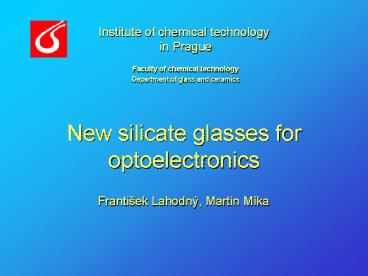New silicate glasses for optoelectronics - PowerPoint PPT Presentation
1 / 15
Title:
New silicate glasses for optoelectronics
Description:
... employed for estimation of the paramagnetic centers E'(Ge) concentration, which ... Ge-paramagnetic center formation by photochemical process. Absorption ... – PowerPoint PPT presentation
Number of Views:45
Avg rating:3.0/5.0
Title: New silicate glasses for optoelectronics
1
New silicate glasses for optoelectronics
Institute of chemical technology in Prague
- Faculty of chemical technology
- Department of glass and ceramics
Frantiek Lahodný, Martin Míka
2
- Integrated optic devices
- - active or passive
- - splitters, couplers, waveguides amplifiers,
gratings
- fabrication by ion exchange method - NaltgtAg
, or NaltgtK - direct laser beam writing method
on photosensitive glass
3
Why silicate glass ?
- high mechanical durability
- chemical stability
- low cost
- better compatibility with today's used systems
(refractive index, material dispersion, )
4
Samples fabrication
- Weight out the raw materials with 0,0001g
accuracy - Homogenization for 20 minutes in mortar
- Melting in Pt-Rh crucibles with the lid at 1480C
- Casting of the melted glass into the iron form
- Controlled annealing
- Cutting and polishing for optical quality
5
Samples homogeneity
- Small 15g samples have bad homogeneity
- Perspective compositions were melted in amount of
100g with Pt stirring device
6
I. research area
- - Laser active silicate glasses with different
Er and Ybconcentrations - - better gain without pumping laser power
enhancement - - improve excitation energy transfer on active
element Er by co-doping partner Yb - - photoluminescence intensity enhancement in
1535nm region - - find the optimal glass matrix chemical
composition and Er/Yb ratio - - chemical composition effect on glass
properties, absorption - and emission bands width, life time
- - undesirable phenomena concentration
quenching,clusters formation
7
Energy transfer on Er a Yb atoms
4I11/2
4I13/2
4I15/2
8
Absorption spectrums for glasses with different
Yb content
- For result gain of the waveguide amplifier is
important the value of the cross-sections (CS) - - absorption CS express the pumping efficiency
- - emission CS express the probability measure
of the stimulated emission - Additional important properties is lifetime of
the excited state - We have studied the influence of the chemical
composition on dynamic viscosity and thermal
expansion
9
Waveguide amplifier gain measurement
Experimental setup for waveguide amplifier gain
measurement
38 mm long planar waveguide amplifier fabricated
byion exchange method (Na?Ag) have6,7dB gain
at 1537nm
10
II. Research area
- Development of the germanate-silicate glass with
photosensitivity properties - Photosensitivity discovered in 1978 by Dr.
Kenneth Hill- local refractive index change
after irradiation in order Dn 10-5-10-2 caused
by structural fails and disorders Color centers
model - - EPR spectroscopy employed for estimation of
the paramagnetic centers E(Ge) concentration,
which cause the refractory index changes
11
EPR measurement and results
- The sample is irradiate by middle-pressure Hg
discharge lamp ( l 240 nm)and EPR spectrum is
collected - EPR signal of the E(Ge) has own characteristic
spectroscopic constant, g- factor (for Ge g
1,99049), it can be uniquely determined in the
spectrum
Ge-paramagnetic center formation by photochemical
process
3,59
App
3,51
1800
3600
Time t s
Signal intensity changes during and after
irradiation
12
UV lamp switch off
Increase and decrease of the E(Ge) signal
intensity during time
13
Resume I. part
- We found perspective laser active silicate glass
doped with Er and Yb - We fabricated functional planar channel waveguide
amplifier with high gain
14
Resume - II. part
- We prepared silicate and borosilicate glasses
with different content of Ge - For best glass increase of the E(Ge) centers
concentration is up to 530 and decrease only 9
after irradiation, refractive index change
Dn10-2 its very promising - Further optimalization and measurements in plan
15
Thank you for your attention































